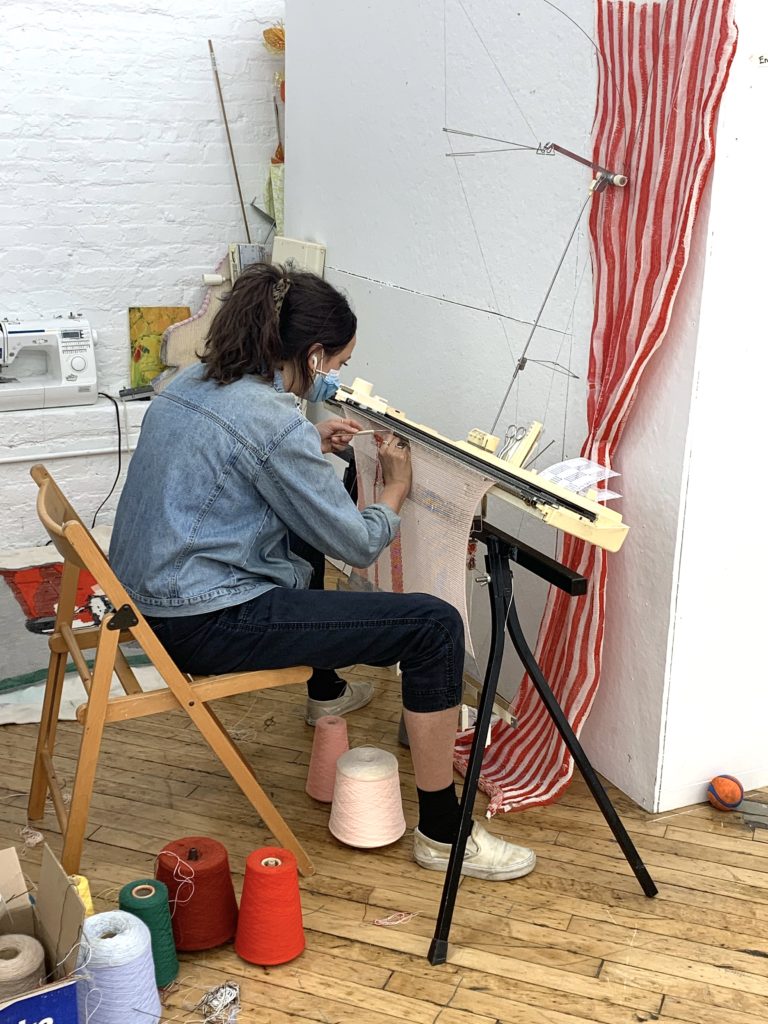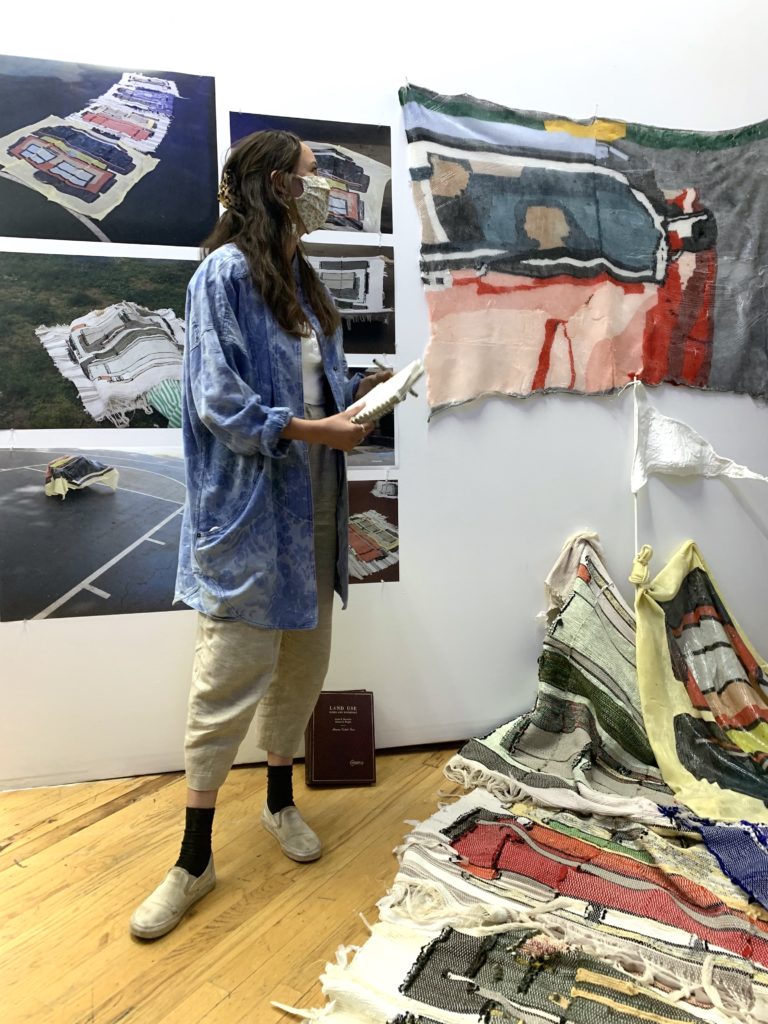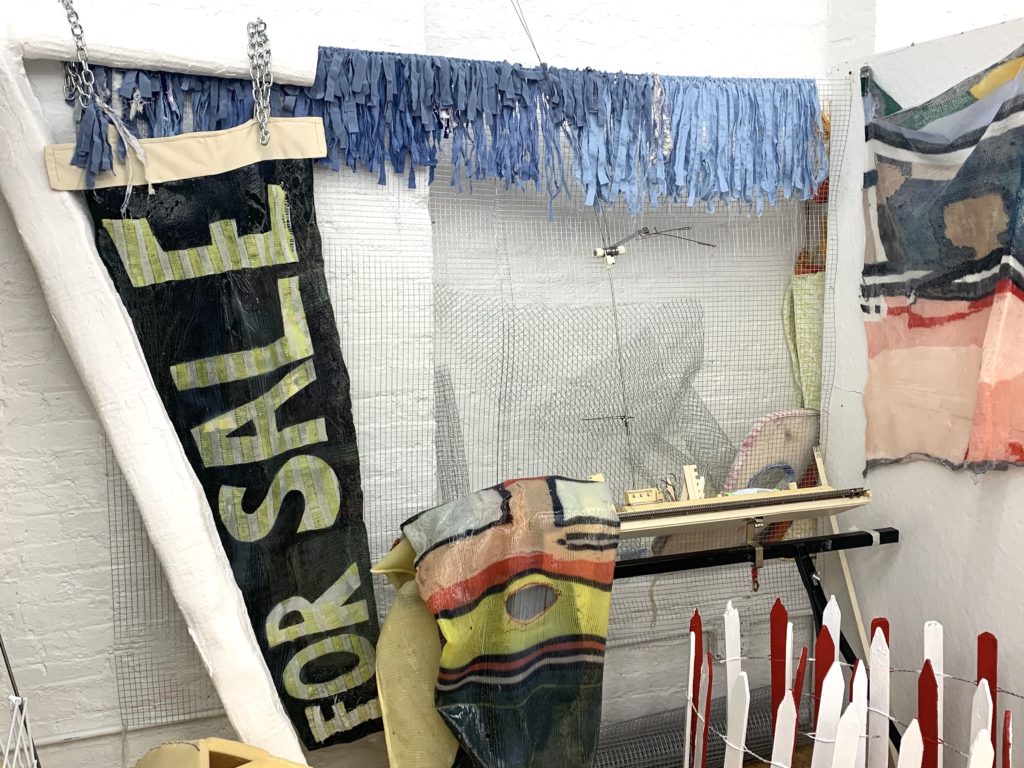AIR Highlight: Emily Small
This conversation took place on June 29, 2021 at the Textile Arts Center with Emily Small and Isa Rodrigues
Video Visual Description:
Footage of Emily Small, wearing a floral patterned dress and hoop earrings, with her dark brown hair tied in a bun, and a light blue face mask. In the foreground on the right hand side is the blurry silhouette of Isa’s light face and dark curly hair. The conversation is happening in Emily’s studio at the Textile Arts Center, and Emily and Isa are sitting across from each other, next to a knitting machine with Emily’s work in progress. In the background, on the walls, are some of Emily’s works, including a large rag woven textile depicting a jeep, a machine knitted landscape covered in silicon depicting a house against a blue sky, and a work in progress of wire mesh covered with blue and white knotted tassels.
Emily Small (she/her) is interested in the ways in which art and design connect and build communities, and how both can invoke critical thinking and connection between groups and individuals. She is a writer, curator, and artist who works with installation, performance, narrative, and collection. She received her BFA from the Rhode Island School of Design in 2018, is a 2022 Columbia University MA (MODA) candidate in Contemporary Art History Critical and Curatorial Studies, and is a 2021/2022 MODA curatorial fellow. She is also a 2020/2021 Artist in Residence at the Textile Arts Center (AIR cycle 12). She is a co-founder of Dollhouse Philly (2019), and MOE: Margin of Error Magazine (2021). She has worked as an assistant at Yowie in Philadelphia. She is co-editor-in-chief for the MODA critical review and is an opening member, host, and curator at Dinner Party Brooklyn.
Isa Rodrigues (she/her) is the co-Executive Director of the Textile Arts Center
Isa: Hi Emily! I’m excited to be talking about your work in your studio. Would you like to start by introducing yourself and maybe telling us a little bit more about your practice?
Emily: Hi Isa! Thank you so much for sitting down and talking with me about my work. I am an interdisciplinary artist, I work in textiles, I've also worked with performance before. I’m a writer, I’m a student, I’ve worked in fashion, so I’ve done a little bit of everything. And I really try to bring that into my work that I’ve been doing in this past year.
Isa: When did you start working with textiles and what drew you to work with fiber materials and techniques?
Emily: So I kind of grew up in a family of women who worked with textiles. Both my grandmothers worked in yarn, one of them knits, the other kind of was an artist and my grandfather was a surgeon and in order to help him continue his practice they developed needlepoint work together, and eventually ended up opening a yarn store in our hometown. So I feel like it was kind of a natural progression for me. My mother taught me how to sew when I was really little and I have always been interested in making my own clothing and in fashion. But I knew I didn’t want to be a fashion designer. I went to school and I felt like textiles, as it was offered as a major, was perfect for me because I would get to learn a lot of new skills but also work with a material that I felt already a really strong connection to.
Isa: I love the story about your grandparents doing needlework together. That’s so lovely! I’m curious if there was any particular technique while you’re in school that you felt it was like your home base - do you want to talk a little bit more?
Emily: Yea, absolutely! You know, we started learning how to weave, how to knit, how to work with fibers and dyeing fabrics, and immediately I connected with knitting. We learned how to use an industrial knitting machine, which is the tool that I make most of my work on, and the tool that we are sitting next to. And I really loved the pacing of it, I loved being able to feel connected to a machine, and in some ways print fabric out. I was so excited to learn this new technique and see almost this technological development, from my grandmother's hand knitting skills that she had passed on to me to being able to make fabrics that I have never seen before. So knitting was something immediately something I connected to.

Isa: So over the past nine months, you’ve obviously been doing a lot of knitting, but also some weaving. But I’m curious to learn more about what’s been the focus of your research and your studio practice during the residency.
Emily: Yea, absolutely. During the residency I’ve been thinking a lot about apocalypse and Americana. And how sometimes, in fact I think often, the two can be one in the same. I’ve been thinking about how there are multiple apocalypses, you know depending on how you define the term. I’ve been really interested in thinking about different definitions of the word apocalypse. The root in Greek means a lifting of the veil, or kind of an unveiling of what’s next. There are different, you know, practices that think of apocalypse as a new beginning, and not necessarily a destructive end, and yet it is a destructive end. I’m also really interested in the fact that in the past two years there has been an increase in infrastructure planning for bunkers, and doomsday prepping has kind of become this industry. And I read Lauren Berlant’s “Cruel Optimism”, which is a book that talks about how national identity is very linked to kind of like compulsory optimisms that may not always be the best for us, or may hinder our flourishing. And I’m really interested in this cyclicality of cruelness and optimism, or rather grief and optimism, I think really is how I’ve been relating it to my practice. So that’s critically kind of what I’ve been thinking of. And translating it through my work, I’ve been thinking a lot about how we prepare, and how we preserve. So, for example, one thing I talk about a lot when I present my work is about the knitting itself. Something I’m really attracted to in knit fabrics is that, unlike a woven fabric where there’s a grid structure (and yarns) that are interplaying in tension to make the fabric safe, a knit fabric is one string that’s just looped around itself continuously. So if there’s a hole, it unravels, the structure is very delicate. And one reason that you like a knit fabric, or that most people would want a knit fabric is to wrap yourself in it, you wear a sweater or a blanket, it keeps you warm, it firms to your body. And so, I’ve been thinking about this kind of interplay between this delicacy and the preservation aspect. So I’ve been covering my knit fabrics in this silicon, which preserves the fabric from the elements, it holds its structure together, its plastic, it won’t degrade, it won’t, you know. decompose. But by covering it in silicon it becomes very sticky and gross and it no longer serves the purpose that you want that knit fabric to function as. So I think there’s something really interesting in while trying to preserve the thing, you ruining the thing itself. And I think that’s how a lot of people move through the world sometimes, or at least I do.
Isa:I loved how you were mentioning that apocalypse can also mean a beginning, but also an end, and I also loved learning more about the connotations of that with your processes. You mentioned, for instance, that you’re covering your knits with silicon, but I’m also looking at the piece behind you that is woven with scraps of fabric and thinking about that old fabric becomes a new body of work. Also, looking at the piece on the wall, that is made with scraps of fabric knotted, that is still in process, so kind of in between beginning and ending, and all. Do you want to talk more about how process also contributes to this idea of apocalypse?
Emily: Yea, absolutely! I think something I was most attracted to, and still am, about textiles is that you can control every process of the making of the objects. So the actual content of the pieces is just as important as the end result, or the sum of its parts. For this piece here behind me, I was working on a body of work that was talking about object oriented discussions and how objects can mediate conversations between two people. And I was using discarded fabric, and ripping it apart, and repurposing the fabric as kind of the material to make the images and I think there’s something really interesting, you know, in this recycling process. Each of the fabrics has their own lives and they contribute to this greater conversation about urgency and about how to convey an idea to somebody when you can’t convey it directly. And I think that recycling it’s such an important part of anything that we make, we have so much material around us all the time and I think that learning how to use that material in new and exciting ways is really important, because not only it’s interesting to take a life that has already existed and repurpose it but, you know, for my own thinking about apocalypse. And of course I love to play with the conceptual side of things, but there’s also a very real thinking about the environmental disasters that we are accruing, the increase in global warming... How do you convey urgency? And how do you convey urgency in a very slow process, like making textiles. So this ripping things apart and putting them back together again, ripping things apart and putting them back together again, repetitive process. For me it’s been really interesting just to think about different ways to repurpose and reuse and what that means, when you’re making objects.

Isa: How has been your experience as a resident at the Textile Arts Center for the last nine months? Do you have any highlights about the program, about the curriculum that you’d like to share?
Emily: Yea, absolutely! I mean, the past nine months has been such a wonderful experience for so many reasons. I think during our current moment it was such a wonderful time to be able to come and be with a cohort of people, and learn and be together and experience new techniques, and new classes. I think meeting new people, in and out, not only the residents, but also the mentors, the critics, the professors that came in and talked to us about writing, about artistic practices. I’ve learned so much about how to be in the professional world of the arts, and I think that’s something I really needed coming into the residency. And I think a particular highlight for me as well, just in my own personal practice, I mentioned this in the beginning, but I do a little bit of a lot of things. So I am a writer, I am a student, I do work in fashion and I do value all of those elements of my practice. I am an artist and I want to continue to push all of those boundaries forward. And so a big, and very, kind of, uncomfortable, question for me coming into the residency is how much could I take, like how much can I do, how much can I live in multiplicity, I guess, in my practices. And I think just being able to have these conversations in the studio has been really helpful for me to feel confident to show myself to the world in the many different facets of the things that I do. I don’t feel like I have to be just one thing and I think that’s something that is very encouraged here, and I really appreciated that.
Isa: As the residency is starting to wind down we’ve been talking more and more about the final exhibition in September. And I’d love to hear more about what you’ll be presenting if you can share with us.
Emily: Yea, absolutely, I’d love to give a little sneak peak. I think for the end of the residency, I’ll be showing a body of work that I’ve been developing that’s really thinking about my own interpretation of apocalypse, like my own experience of apocalypse growing up, my own cycles of grief and optimism, and how they relate to these greater structures of ideas that I’ve been thinking about. The way that I’m hoping to do that is going to be through hiding little bits of work, the idea maybe being that the viewer would walk through the debris and detritus of my apocalypse. And as they see the rest of the show they also notice, you know, up in a corner by an exit sign or off to the side, this interconnected body of work that’s a little bit sad, a little bit, perhaps, hinting of something that has gone a mess, or something that has gone awry, and a knowledge that there’s something kind of uncanny and worrisome in the presence of also all the beauty that is in my artwork, hopefully. So the two pieces that are behind me here will be part of the exhibition. (Pointing at the work) This is a silicon piece of a lot of sky and a little bit of a rooftop of a barn. I love this piece, I think there’s something very startling about looking up at the vast expansive blue sky, seeing a little bit of rooftop. I also have it draped in the silicon continuing this idea of preservation and decay, and hopefully holding that tension there. Like I said, this is kind of one of those memory pieces. (Pointing at the knotted tassel work) And this piece here is a work in progress that will be this big tornado slash parade float combination and I hope to have that kind of stashed in the rafters somewhere, you know, a little bit like you could almost go about it unnoticed but when you do see it, the work is being brought back down to Earth, is being seen again. So those are two pieces that I’m going to be including but a little bit also what I’m thinking about the viewer's experience walking through the work.

Isa: Any upcoming plans or projects for after the residency that you’d like to share?
Emily: Yea, absolutely. In addition to continuing the body of work that I’ve started here, I have a few things that I’ve been working on. I will be starting a journal with one of my friends, kind of thinking about this idea of containing multiplicity. We are really excited about it being a multidisciplinary journal, where the writers and the artists that are included have interviews between each spread and so the whole book will be this conversation of work, and of medium, and of ideas. So that’s one big passion project that I’m working on right now. I’m also a student, so I’ll be finishing my last year of school, which is really exciting. And (I’ll be) going out into the world and seeing again how I can continue to combine all my interests and practices. And then finally, I’m actually on the opening staff of a restaurant right now, in Fort Greene, called Dinner Party and it’s dinner/theater restaurant. So we’re experimenting with menus, but also experimenting with performance. Every night, hopefully, will be a different performance, and we’re really excited to bring artists into the space, and to really just use the idea or model of the restaurant as a gallery, as a stage, as a performance house of many ways. So we’re really really excited about that and a lot of my energy and artistic excitement is also going into that project as well.
Isa: Thank you Emily, that’s so exciting. And I love how you always find ways to bring everything that you’re interested in together, like you’re a great gatherer (laughs) of all different expressions of arts. Thank you for sharing, this was so nice.
The TAC AIR 12 Final exhibition, Considering Mass and Density, will be on view at the Textile Arts Center from September 13-26, 2021.